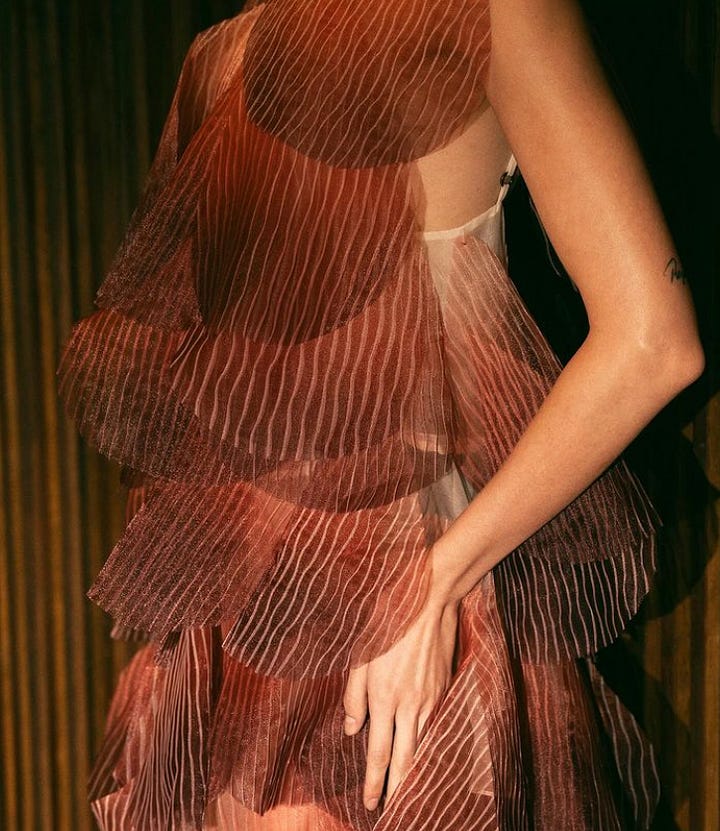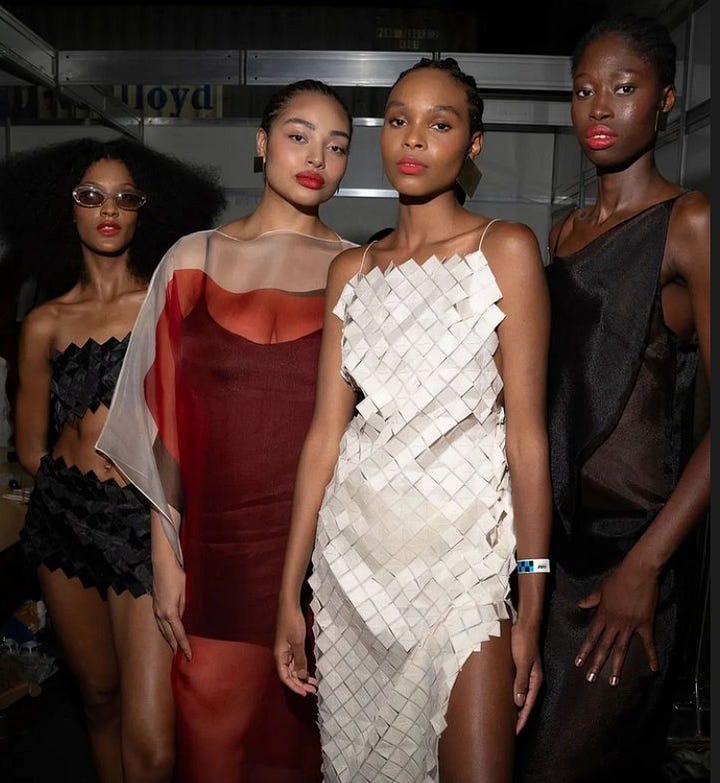Although some might think Brazilian fashion is all about Brazil's core, the clever ones know that São Paulo Fashion Week showcases the true meaning of the country’s fashion. It goes beyond soccer t-shirts, ripped jeans, and quirky sunglasses, and SPFW allows creators to feature that on a wider scale. And even though some fashionistas may not be very enthusiastic about the event, either for the notable celebrity endorsement or the elevated number of gimmicks, some points make all that dissatisfaction worth it, such as the display of all the influences present in such a multicultural country. Some focus on sustainability aspects, while others go for native culture, religion, horoscope, folklore, or history. The differential of SPFW, among all other fashion weeks, is that designers explore distinguishable themes rather than similar ones - and you will see this by reading this.
On November 8, opening São Paulo Fashion Week N56, Patricia Vieira transformed her label’s runway into a disco party, where besides shimmery lights and mirror balls adorning the place, there were also models full of glitz and glam-metalized looks enjoying the moment. Vieira was feeling the 70s, and in that time, music, shine, movements, and glam ruled the dance floor. With a considerable twist, Vieira added leather looks, presenting perhaps a modern concept of the glowing decade.
The pleasant glamorizing pattern on the first day of the Brazilian fashion event kept reigning São Paulo’s air in João Pimenta’s show. Savoring the beat and brilliance that is always appreciated, Pimenta weaved his collections that combined menswear and womenswear techniques with gold threads, which brought an opulent and divine element to tailoring suits influenced by religious syncretism in Brazil.
Also influenced by religion, Angela Brito presented her Romaria collection, focusing on clothing inspired by the saint's festivals that occurred in the islands of Cabo Verde, the designer's hometown, and in many other regions of Brazil. Brito's creative process was based on a serene, airy, atemporal, natural, and summery tendency, accompanied by its sacred distinguishable aspect.
Remaining in spiritual and divinity terms, Walério Araújo dedicated his collection to astrology and the symbolisms of horoscopes, alluding to a surrealist dimension where twelve of the looks represented one of the Western and other twelve of the Chinese zodiacs, leading to the runway three-dimensional pieces with unexpected-maximalist forms.
Optical illusions, sculptural elements, and architectural aesthetics had a notable impact on André Namitala's Handred, as well. Conveying throughout his designs the Brazilian modernism art, Namitala used new materials, techniques, textures, and fabrics for innovation.
David Lee’s collection, which also had an inventive approach, draws inspiration from various levels of the wind, from the soft breeze to tornados. Adding patchwork, knitwear, and kitesurf, a popular adornment in towels and kites on the Ceará coast, to pants, tweeds, and jackets, nature and culture walk side by side while transforming Brazilian fashion.
Brazilian fashion transformation wasn’t exclusive to David Lee and the previous creators mentioned though. With the designer Helô Rocha back in São Paulo Fashion Week after six years, the sertão, a dry location in the Brazilian northeast, was transformed into the sea. Or, at least, that is how her comeback was named.
The show, with its impacting title, highlights the celebration of her origins and the cultural aspects of her homeland, Natal. Rocha turned her runway into a storybook by handcrafting each garment. Every piece told a fable, and the materials used - like latex, knit, lace, and fluid fabrics - helped convey the narrative. The combination of many styles of fabrics has even created new visuals, textures, and emotions, which was indeed a standout moment of the entire event.
Since emotions never go out of style, Renata Buzzo’s collection combines the sea, the moon, and relationships in a representation of handmade dresses with textures that recall the movement of the waves and the glow of the moon. And the feelings are internalized in the audience, either by personal experiences or garmental ones. We choose who or what unleashes those sentiments.
Specialists in causing deep emotion, the premise of combining feelings with art also applies to Hisan Silva and Pedro Batalha designers, whose Dendezeiro collection explored the nostalgia of their Brazilian and Bahia cultures. The retrospective has looked at popular elements by creating shapes and prints to represent the brand's agender style while exploring these classic symbols of Brazilianness. Using tapestry to decorate the pieces, supermarket sign prints, and a bag with a drum design, the designer duo presented interpretations of their roots and nationality, such as a giant parasol on the back of a look, a red jumpsuit inspired by a shop assistant, prints that simulate supermarket offers and crochet table sets.
Knitwear was also the main star in Água de Meninos, the new collection from Ateliê Mão de Mãe. This season, Vinicius Santana, Patrick Fortuna, and Luciene Brito were inspired by the São Joaquim Market, a traditional popular trade fair in Salvador, bringing their famous crochet with some new twists, such as a bridal look made with crinoline. In footwear, the sandals and flip-flops with macramé details resulted from a collaboration with Havaianas, a famous Brazilian slipper label, which certainly is a symbol of our culture.
Other aspects of our culture include its respect for the artisan craft that was also present in Weider Silveiro’s collection. Keeping the exploration of regional craftsmanship done elegantly, Silveiro blends lace with tapestry techniques, once again uniting tradition with the essence of his label’s clientele.
Likewise, at the core of his label, João Maraschin showed a collection that emphasizes the strength of handmade in his brand and the whole business of Brazilian Fashion. Focusing on textures and the sensorial spirit, sustainability highlights the surfaces while demonstrating notable care for its materials, such as fibers from plastic bottles, tint of fruits and vegetables, and pirarucu leather.
Also, quite a texture and environment-based, Marina Bitu drew inspiration from the various textures and patterns found in different fungi species. She later mentioned that fungi play an essential role in maintaining ecosystems and the cycle of life, which reminds her of the female body and its generative capacity, leading her to explore the concept of femininity through fluid silhouettes. Nature was also the inspiration for her swimwear brand Sau Swim, which presented its debut, evoking many landscapes throughout fashion, like the cut-outs in the shape of dunes or the piping sewn upright to form silhouettes of Cactos on linen garments.


When many hear Brazilian creators focus on nature and sustainability, there is some frustration behind it. However, do not confuse ecological with unfashionable. For trends lovers, specifically "quiet luxury", Mateus Cardoso presented a collection worthy of the trend, with rigorous tailoring, harmonious proportions, and neutral tones. Through pure sophistication, Cardoso stands out nationally and somehow challenges brands that are too concentrated on the motto of being a "stealth wealth" label but with non-sustainable and non-durable materials.
While homages to Brazilian culture and its nature fill São Paulo Fashion Week collections, Boldstrap closed the event with a collection inspired by 2000s high school. Combining preppy uniform pieces with some bondage and punk icons, actress and model Camila Queiroz opened and closed the show. Her initial look was a magenta checkered corset and skirt set, with a long matching trench coat, and the grand finale appealed to the most extravagant jeans and leather bodice, combined with fishnet socks, which was enough to attract screams and flashes from the audience while maintaining her very lively and charismatic walk.
During all seasons of São Paulo Fashion Week, it is noteworthy to observe the prevalence of natural fabrics and gender-neutral looks from the audience's perspective. However, the trends that stood out in this particular edition were fringes, seen from Apartamento 03 to João Maraschin, overlaying as observed in David Lee's designs, and clothing reminiscent of sculptures, such as Lino Ventura's mermaid-like dresses and Handred's monumental inspired ones.
Overall, the 38 national labels have showcased the diversity of creation of Brazil and how many thematics can be explored while adding innovation and eco-friendly techniques. Their way of making fashion using raw materials shows that Brazilian fashion is not only about the artistic process and the runway display but also about sincere performances full of energy and charisma that stand out for their rarity in the immensity of the industry. And among all the trends, allure, some attempts of stunts, and the existent celebrity praise, few conclusions could be as impactful as its uniqueness.





















Somehow I didn’t even know there’s a fashion week in Brazil, loved seeing the different pieces from it!